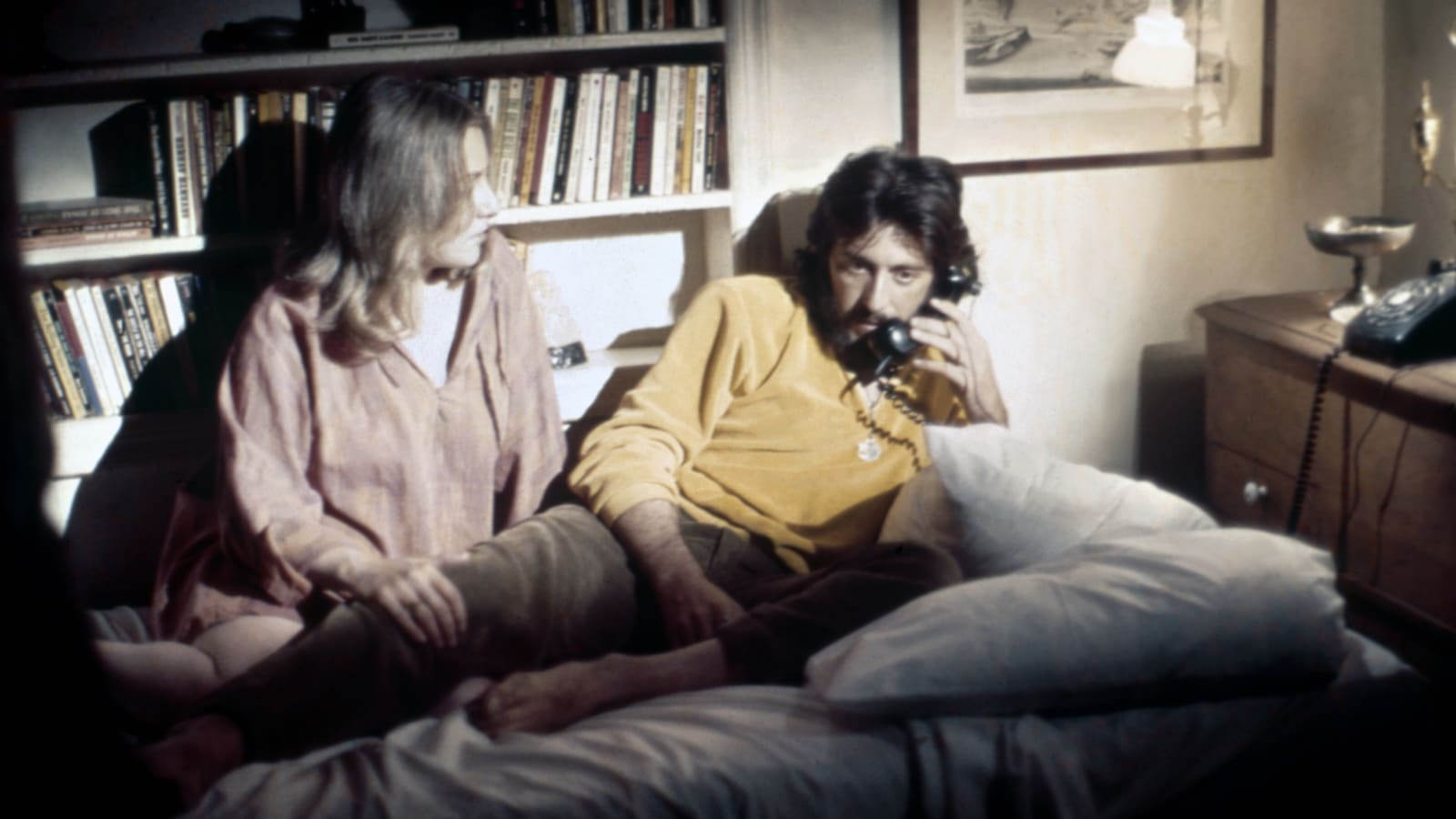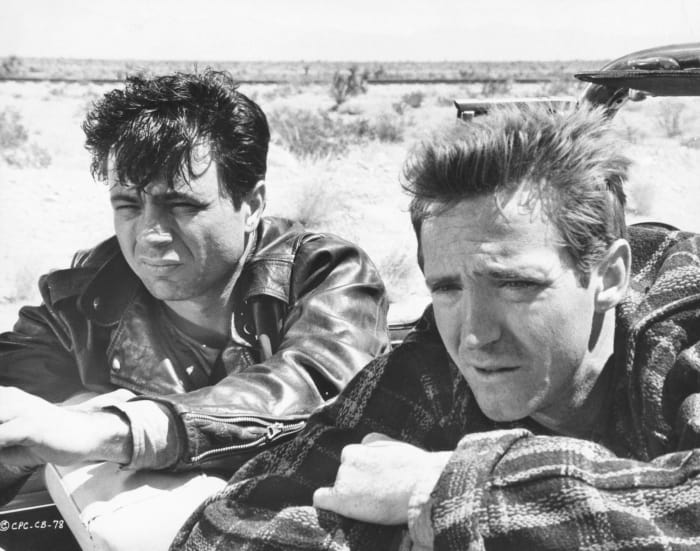We all love pulpy stories about mobsters, serial killers, petty criminals, corrupt politicians and, in general, anyone who gets on the wrong side of the law. That's why true crime stories are often sit atop of The New York Times bestseller list. And what moves units at the book store is almost certain to sell tickets at the movie theater or light up the Nielsen ratings (to wit, one of the longest running television franchises in television is the ripped-from-the-headlines procedural "Law & Order"). But some trips to the dark side are more luridly entertaining than others. Let's take a look back at the true crime genre's greatest hits from the last century.
1 of 25
"In Cold Blood" (1967)
John Springer Collection/CORBIS/Corbis via Getty Images
With its novelistic approach to what is essentially a scrupulously researched feat of deep-dive reportage, Truman Capote’s “In Cold Blood” established the template for today’s true crime genre. The book focuses on the massacre of the Clutter family in Holcolmb, Kansas by two ex-convicts named Dick Hickock and Perry Smith. It was a bestseller the minute it hit bookstores in 1966. A year later, director Richard Brooks delivered a masterfully constructed film adaptation starring Robert Blake and John Forsythe.
2 of 25
"Helter Skelter" (1976)
Michael Ochs Archives/Getty Images
After successfully prosecuting Charles Manson for orchestrating the Tate-LaBianca murders, Vincent Bugliosi wrote the book on the case in “Helter Skelter.” It’s the top-selling true crime book of all time, and spawned a two-part made-for-CBS movie starring Steve Railsback as Manson in 1976. The TV movie is obviously a sanitized version of the book (which recounts the crime scene in revoltingly exact detail), but it’s still a captivating courtroom thriller. There was a pointless remake in 2004.
3 of 25
"The Thin Blue Line" (1988)
Bettmann / Getty Images
Documentaries really don’t belong on this list, but we’ll make an exception for Errol Morris’s “The Thin Blue Line” which employs dramatic reenactments and a mesmerizing Philip Glass score to argue for the innocence of Randall Dale Adams, who was sentenced to death for the murder of a Dallas police officer. Morris’s film made such an airtight case for Adams’s innocence that the state overturned his conviction and set him free.
Bettmann / Getty Images
The hunt for the Northern California-based Zodiac Killer throughout the 1970s is the “Moby Dick” of serial killer investigations. The murderer taunted law enforcement and terrorized the entire Bay Area by writing letters to the local newspapers in which he threatened, among other horrors, the massacre of school children (thankfully, he never followed through.) The exhaustive manhunt for the never-captured Zodiac is recounted in David Fincher’s spellbinding procedural “Zodiac.”
5 of 25
"Memories of Murder" (2003)
HONG JIN-HWAN/AFP/Getty Images
South Korea’s “Hwaseong serial murders” stretched out over five years, befuddling an entire law enforcement apparatus that had never dealt with a serial killer before. There were ten victims in all and the murderer was never caught, prompting comparisons to the unresolved Zodiac killer investigation. So it’s appropriate that the film based on the killings, Bong Joon-ho’s exceptional “Memories of Murder” is eerily similar to Fincher’s “Zodiac” (though Bong beat him to production by four years).
6 of 25
"Citizen X" (1995)
Georges DeKeerle/Sygma via Getty Images
The imaged obsessed Soviet Union was uniquely ill-equipped to deal with a serial killer in the 1980s. The country’s leaders believed serial killers were emblematic of American moral rot, and that such crimes could not happen in their superior country. They were wrong, and their bureaucratic efforts to cover up Andrei Chikatilo’s murders resulted in the death of fifty-two women and children. The frustrating search for Chikatilo is the subject of the little-seen (and quite good) made-for-HBO movie “Citizen X” starring Stephen Rea and Donald Sutherland.
7 of 25
"The People v. O.J. Simpson: American Crime Story" (2016)
POO/AFP/Getty Images
The truth of the O.J. Simpson murder trial was often stranger than fiction, but the behind-the-scenes machinations of the overwhelmed prosecution and the Hall of Fame running back’s “dream team” defense made for stunning television a second time in FX’s “The People v. O.J. Simpson: American Crime Story.” For those who followed the case closely, there weren’t any major revelations in the series; it was just first-rate television.
8 of 25
"Heavenly Creatures" (1994)
David Levenson/Getty Images
The Parker-Hulme murder case rocked New Zealand in the 1950s. The details were shocking: two teenage girls, Pauline Parker and Juliet Hulme, were driven by a fear of separation – their parents believed they might be engaged in a homosexual relationship – to bash Pauline’s mother’s skull in with a brick wrapped in a stocking. The bizarre story was retold in Peter Jackson’s tragic and heartbreaking “Heavenly Creatures” (starring the then up-and-coming duo of Kate Winslet and Melanie Lynskey.)
9 of 25
"At Close Range" (1986)
Orion/Getty Images
In the 1970s, Bruce Johnston ran a crime syndicate out of Chester County, Pennsylvania that stole just about anything of value they could get their hands on: antiques, farm equipment, jewelry and, of course, money. As the authorities closed in, Johnston authorized the murder of six younger members of the gang as a means of covering up their misdeeds. He was convicted of all six slayings in 1981 after his son testified against him. This tragic family drama was replayed with different names (and significant fictional license) in James Foley’s superb “At Close Range” starring Sean Penn and Christopher Walken.
10 of 25
"The Honeymoon Killers" (1970)
American International Pictures/Getty Images
Raymond Martinez and Martha Beck became known as “The Lonely Hearts Killers” for their string of murders that preyed upon people looking for potential romantic matches via personal ads in the local newspapers. Between 1947 and 1949, the duo killed as many as twenty people. They were captured, convicted and subsequently executed in 1951. Their lurid tale was terrific tabloid fodder, and was later elevated to a strange kind of romantic art in Leonard Kastle’s 1970 cult classic “The Honeymoon Killers.”
11 of 25
"10 Rillington Place" (1971)
Ian Showell/Keystone/Getty Images
Between 1943 and 1953, John Christie killed at least eight people in his flat at 10 Rillington Place in Nottingham, London. The murders were scandalous enough, but the true outrage was the miscarriage of justice that led to the wrongful conviction and execution of Christie’s neighbor Timothy Evans for the murder of Evans’s wife and baby daughter (Christie definitely killed the child and almost certainly killed the wife). Richard Fleischer’s “10 Rillington Place” takes a quasi-journalistic approach to the Christie-Evans saga, and features a tremendous performance by John Hurt as the innocent Evans.
12 of 25
"Dog Day Afternoon" (1975)
Warner Bros./Archive Photos/Getty Images
In 1972, John Wojtowicz and Salvatore Naturale held up a Chase Manhattan branch in Brooklyn in part to abscond with enough money to pay for Wojtowicz’s wife’s gender reassignment surgery. The hold-up was botched, and the pair went to prison, though Wojtowicz’s wife did eventually have her procedure. The story gets a heightened retelling in Sidney Lumet’s classic “Dog Day Afternoon” in which Al Pacino tries to bluster his way out of the heist-gone-horribly-wrong.
13 of 25
"Henry: Portrait of a Serial Killer" (1986)
Robert Daemmrich Photography Inc/Sygma via Getty Images
No one knows for sure how many people Henry Lee Lucas murdered. He claims it was over 3,000, but this number has been debunked as outrageously overinflated. He was convicted and sentenced to die in Texas for eleven killings, but, over the years, he’s been credited for many, many more. His life as a murderous drifter inspired John McNaughton’s deeply disturbing “Henry: Portrait of a Serial Killer” with Michael Rooker playing a fictionalized version of the remorseless, dead-eyed Lucas.
14 of 25
"The Onion Field" (1979)
Mondadori Portfolio via Getty Images
On March 9, 1963, Police officers Ian Campbell and Karl Hettinger were kidnapped at gunpoint by a pair of criminals on the corner of Carlos and Gower in Los Angeles, California. They were driven north to an onion field near Bakersfield where Campbell was executed. Hettinger escaped, and his testimony led to the conviction of the murderers, but his psychological torment was just beginning. Harold Becker’s “The Onion Field” is a moving adaptation of Joseph Wambaugh’s bestseller featuring excellent performances from John Savage, Ted Danson and James Woods.
15 of 25
"River's Edge" (1987)
Island Pictures/Getty Images
Neal Jimenez’s quietly horrifying screenplay for “River’s Edge” is loosely based on the 1981 rape and murder of Marcy May Conrad at the hands of Anthony Jacques Broussard. After the killing, Broussard bragged to friends and showed off her corpse, which he’d dumped in a ravine, to around ten people. It took two days for a couple of classmates to go to the police. Directed by Tim Hunter, the film takes a matter-of-fact approach to the crime after the crime, allowing the talented young cast (including Keanu Reeves, Ione Skye and Crispin Glover) to find the traces of humanity in these emotionally numb kids. It’s tough, essential viewing.
16 of 25
"The Executioner's Song" (1982)
Bettmann / Getty Images
Gary Gilmore was the first person to be executed in the United States after the Supreme Court ruled in 1976 that the state of Georgia could legally execute Troy Leon Gregg for murder. How did Gilmore get out in front of Gregg? He asked for it. Gilmore’s story was the focus of Norman Mailer’s bestseller “The Executioner’s Song” which was subsequently turned into a TV movie starring Tommy Lee Jones in an Emmy-winning turn as the man who requested to be put to death by firing squad as punishment for committing two murders in the summer of 1976.
17 of 25
"Goodfellas" (1990)
Warner Brothers/Getty Images
“As far back as I can remember, I always wanted to be a gangster.” Henry Hill got his wish, and his exploits as a member of the Lucchese crime family – including the $6 million Lufthansa heist in 1978 – are exhilaratingly detailed in Martin Scorsese’s all-timer “Goodfellas.” The movie ends with Hill entering witness protection after squealing on his associates, but the motor-mouthed mobster gabbed his way out of the program. He became a frequent guest on “The Howard Stern Show” and died in 2012 of a heart attack – a rare, nonviolent end for a gangster.
18 of 25
"The Boston Strangler" (1968)
Twentieth Century Fox Film Corporation/Sunset Boulevard/Corbis via Getty Images
When Richard Fleischer made “The Boston Strangler” in 1968, Albert DeSalvo had just been sentenced to life in prison for confessing to the murders of thirteen women earlier in the decade. At the time, the most fascinating aspect of the case was DeSalvo’s insanity defense, and the hypnosis used by AG John Bottomly to obtain a confession (which Fleischer depicts in the film’s transfixing finale). Over the years, however, there is credible reason to believe that DeSalvo took credit for a number of crimes he didn’t commit. DeSalvo’s body was exhumed in 2013 for a DNA test, which returned a near 100% match with seminal fluid found at Mary Sullivan’s murder scene. Several other killings are still under dispute.
19 of 25
"The Young Poisoner's Handbook" (1995)
Keystone/Hulton Archive/Getty Images
The strange tale of Graham Young, “The Teacup Murderer,” began in the early 1960s when, as a teenager, he became fascinated with poisons and how they interacted with the human body. Unfortunately, Young wasn’t satisfied with reading and laboratory study; he had to put his lethal concoctions to the test. Young was placed in a mental hospital after confessing to the attempted murders of family members (he may have actually killed his stepmother) and was released in 1970 when it was determined he’d grown out of his obsession with poisons. He hadn’t. Young’s trail of sickness and death (he killed at least two people) was turned into the brilliant dark comedy “The Young Poisoner’s Handbook” in 1995.
20 of 25
"All the President's Men" (1976)
Warner Bros./Sunset Boulevard/Corbis via Getty Images
Where we all learned to “follow the money” and that the cover-up is often far worse than the crime. Alan J. Pakula’s sensational adaptation of Bob Woodward and Carl Bernstein’s “All the President’s Men” was released just two years after President Richard M. Nixon’s resignation, but it was still (and remains) as suspenseful as the most finely wrought murder mystery. Just remember, kids: when you break into a building, the tape goes vertical along the lock.
21 of 25
"Casualties of War" (1989)
Columbia Pictures/Getty Images
On November 19, 1966, a group of American soldiers raped and murdered young Phan Thi Mao, whom they’d kidnapped from a Vietnamese village to serve as “portable R&R” during a reconnaissance mission. The atrocity known as the “Incident on Hill 192” became the subject of a New Yorker article by Daniel Lang, and was later turned into a harrowing film called “Casualties of War” by director Brian De Palma. It is one of the legendary filmmaker’s finest works, though be forewarned: it does not soft-pedal the viciousness of these disgraceful men.
22 of 25
"The St. Valentine's Day Massacre" (1967)
Los Altos Productions/Getty Images
The most notorious mass murder in American mob history is reconstructed from conception to literal execution by filmmaker Roger Corman in this severely underrated 1967 movie. It’s an unusually big (i.e. pricey) production for the notoriously thrifty director, and was greenlit in part to capitalize on the popularity of gangster shows on television. But rather than make a violent, pulpy mob flick, Corman demonstrates how this was a political power play on Al Capone’s behalf. It’s a pretty talky movie (in a good way) until the tommy guns come out in the final scene.
23 of 25
"Paid in Full" (2002)
Theo Wargo/WireImage
Azie "Ace" Faison was a poor high school dropout from the Bronx who dreamed of a better life than pulling down minimum wage at a local dry cleaners. The year was 1984, the drug of choice in Manhattan was cocaine and the money to be made seemed limitless. Faizon’s rise from poverty to high-rolling drug dealer is the stuff of New York City legend. Faizon famously took nine bullets during a botched robbery of his stash house, survived, and turned himself into a cautionary tale as a way of keeping youngsters from making his mistakes. His rise and fall and rebirth is the subject of Charles Stone III’s “Paid in Full,” which Faizon co-produced with Jay-Z and Damon Dash.
24 of 25
"The Wrong Man" (1956)
Warner Brothers Pictures/Getty Images
“The difference lies in the fact that this is a true story, every word of it.” This reassurance might seem suspect coming from the mouth of Alfred Hitchcock, but he’s generally on the level with this statement. The story of struggling musician Manny Balestrero (Henry Fonda) being mistakenly identified as an armed robber is taken from the book “The True Story of Christopher Emmanuel Balestrero” and aside from a few factual omissions that help amp up the tension, it’s true to life. The story itself isn’t terribly consequential compared to the other titles on this list, but Hitchcock nonetheless ratchets up the suspense.
25 of 25
"Serpico" (1973)
Jim Garrett/NY Daily News via Getty Images
Frank Serpico is still speaking out on corruption and injustice at the age of eighty-one, no thanks to the efforts of his former colleagues in the New York Police Department. Serpico was less than a decade on the job when, as a plainclothes officer, he encountered massive corruption within the force. He blew the whistle, exposed the issue and got appointed to the Knapp Commission on police corruption. A year later, he was shot in the face by a drug dealer and left for dead by his fellow officers. This is all covered in Sidney Lumet’s classic 1973 biopic “Serpico” starring Al Pacino as the crusading policeman.

 +
+

































